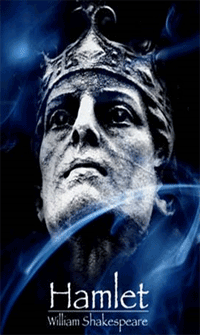
A prototype in which a live performance of a scene from Hamlet will be combined with both live and prerecorded video footage displaying the scene from different camera angles and perspectives from which the audience will be able to select their preferred view.
Movies are capable of conveying emotion and subtext in a scene through the use of different camera angles - extreme close-ups are often used to intensify dramatic facial expressions from a character and first-person perspective shots allow audience members to see through the eyes of another person. Traditional theatre does not benefit from multiple camera angles, and the only perspective an audience member gets on a scene is the one from his/her seat. Our goal is to change this by building a prototype around the notion of perspective, and allowing audience members (5-10 people for the prototype) to interactively change their viewpoints throughout a theatrical performance.
Technology will help us to achieve our goal with this prototype by allowing us to incorporate elements of cinematography into live-action theatre, and give audience members the ability to experience a scene from different perspectives without ever moving from their seats. This can be done through the use of live and prerecorded video footage that could be displayed on projection screens and juxtaposed to the live performance itself. Audience members should be able to view a scene being acted out live while also making meaningful choices that allow them to simultaneously view the scene from different perspectives. This level of interactivity between audience and play should heighten the meaning of the play's content without detracting from the overall performance, and create a richer theatrical experience for all involved.
Development for this concept was halted halfway through the semester. The storyboards and technology were developed to about 70% completion before our team focused all our efforts on producing the interactive performance of Rashomon.
Design Document
Plot
This prototype was designed for use with Act 3, Scene 4 of Hamlet. Plot summary as provided by wikipedia:
Gertrude summons Hamlet to her closet to demand an explanation. On his way, Hamlet passes Claudius in
prayer but hesitates to kill him, reasoning that death in prayer would send him to heaven. In the
bedchamber, an argument erupts between Hamlet and Gertrude. Polonius, who is spying on the whole
scene behind an arras, panics when it seems as if Hamlet is about to murder the Queen and cries
out for help. Hamlet, believing it is Claudius hiding behind the arras, stabs wildly, killing Polonius.
When he realizes that he has killed Ophelia's father, he is remorseful. The Ghost appears, urging Hamlet
to treat Gertrude gently but reminding him to kill Claudius. Unable to see or hear the Ghost herself,
Gertrude takes Hamlet's conversation with it as further evidence of madness. Prior to embarking for
England, Hamlet hides Polonius's body, ultimately revealing its location to the King and Gertrude.
Characters
Hamlet
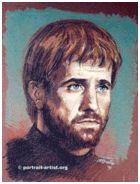 The Prince of Denmark, and son of Queen Gertrude and the late King Hamlet, and the nephew of the present
king, Claudius. Hamlet is melancholy, bitter, and cynical, full of hatred for his uncle's scheming and
disgust for his mother's sexuality. A reflective and thoughtful young man who has studied at the
University of Wittenberg, Hamlet is often indecisive and hesitant, but at other times prone to rash
and impulsive acts.
The Prince of Denmark, and son of Queen Gertrude and the late King Hamlet, and the nephew of the present
king, Claudius. Hamlet is melancholy, bitter, and cynical, full of hatred for his uncle's scheming and
disgust for his mother's sexuality. A reflective and thoughtful young man who has studied at the
University of Wittenberg, Hamlet is often indecisive and hesitant, but at other times prone to rash
and impulsive acts.
Gertrude
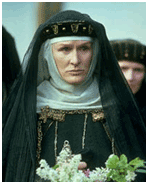 The Queen of Denmark, Hamlet's mother, recently married to Claudius. Gertrude loves Hamlet deeply, but
she is a shallow, weak woman who seeks affection and status more urgently than moral rectitude or truth.
The Queen of Denmark, Hamlet's mother, recently married to Claudius. Gertrude loves Hamlet deeply, but
she is a shallow, weak woman who seeks affection and status more urgently than moral rectitude or truth.
Polonius
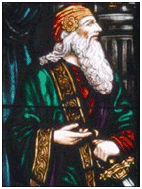 Chamberlain of Claudius's court, a pompous, conniving old man. Polonius is the father of Laertes
and Ophelia.
Chamberlain of Claudius's court, a pompous, conniving old man. Polonius is the father of Laertes
and Ophelia.
Rosencrantz and Guildenstern
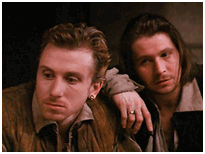 Two slightly bumbling courtiers, former friends of Hamlet from Wittenberg, who are summoned by Claudius
and Gertrude to discover the cause of Hamlet's strange behavior.
Two slightly bumbling courtiers, former friends of Hamlet from Wittenberg, who are summoned by Claudius
and Gertrude to discover the cause of Hamlet's strange behavior.
Setting
Shakespeare's Hamlet is set in Elsinore Castle in Denmark. The scene we have discussed using for our prototype specifically takes place in Queen Gertrudess bedchamber. Hamlet is a tragedy and therefore has a dark tone to it. However, we are trying to incorporate elements of Rosencrantz and Guildenstern are Dead into our prototype, which can add a slightly more comedic feel to it. Since our performance will focus mainly on a scene from Shakespeare's original play, we should try to stay consistent with the darker tone, but there may be some room for humor if we show Polonius' death to be an indirect cause of Rosencrantz and Guildenstern's rather comedic actions. This is something we will need to consider when testing the idea.
Stage
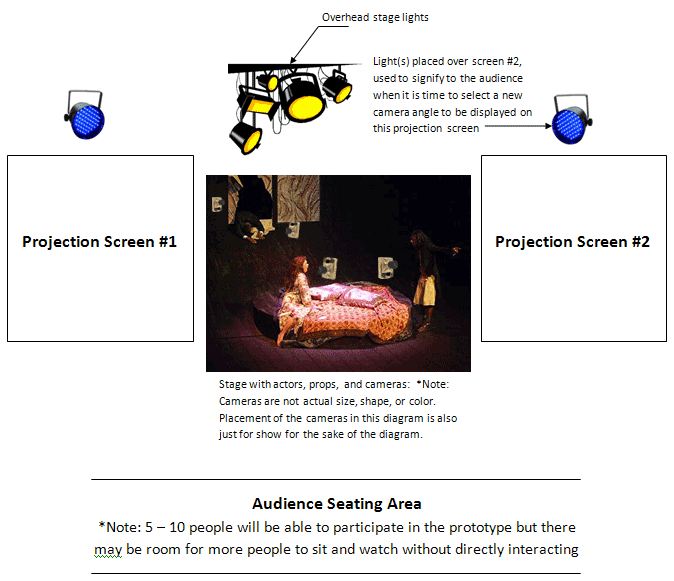
Stage Setup
Our venue will be a traditional theatre setup with the audience all facing the stage at the front, however we will add two large projection screens off to the left and right sides of the stage. Cameras will also be strategically placed around the stage so that we get meaningful shots of the action without breaking the illusion of the play. Along with overhead stage lights, other lights should be placed somewhere above each screen. There will be some instances in the play where the audience will be given a chance to vote on camera angles they would like to view, and these points in time can be represented by small lights which we will use in a subtle, intelligent manner to signify to audience members when it is time for them to select a different camera angle to appear on one of the two projection screens. These moments will be worked into the performance (introduced during extended moments of silence, etc.) so that the selection process does not compete with the play or detract from the stage action in any manner. The selection mechanic could be explained to the audience before the performance, perhaps in an announcement or in a playbill.
Camera-Angle-Selection Screen
When it is time for audience members to choose which camera angle they would like to see displayed on one of the projection screens, we will first project all of their choices onto the screen. Audience members will be presented with anywhere between 2 - 4 different camera angle options from which they can select one to be projected in full during a portion of the performance. Each option should have a letter (A - D) designated to it, which should correspond with the letters on the audience members' Beyond Question (BQ) remote controls.
Play Through
Short Tutorial
Screen #1 (located just off of stage right) will display a text description of what will happen on the screen when it is time for the audience to select from a number of camera angle choices. This text will go over how to use the Beyond Question remotes to pick one of the 2-4 choices displayed on the screen. During this time, Screen #2 (located just off of stage left) will show a visual tutorial aide.
Action!
The scene opens with two separate visuals fading in on Screens 1 and 2. No action is occurring on the stage yet. Screen #1 will display prerecorded footage of Hamlet walking up the stairs, headed toward Queen Gertrude's bedchamber. After Screen #1's image has been displayed for about 10 seconds, lights should illuminate the stage, revealing Queen Gertrude and Polonius alone in the Queen's bedchamber. At this time, Screen #2 should show a live feed coming from a camera strategically positioned somewhere on the stage so that it displays an over-shoulder angle from Gertrude's perspective on the doorway from which Hamlet will soon make his entrance. Images are displayed on the screens before any live action occurs so that the audience can familiarize themselves with the filmed footage, which will consist of prerecorded footage and live feed - both on display here at the beginning of the scene.
After 30 seconds of showing the images on the screen, the live action will begin on stage as the actors playing Gertrude and Polonius begin a brief discourse about Hamlet's recent behavior. After the two talk, Polonius goes and hides behind a tapestry in the bedchamber, located at stage right (location of the tapestry is important because we will eventually present the audience with a camera angle depicting Polonius's POV from behind the tapestry, and that camera angle should not show any of the audience members seated, watching the performance). When Polonius takes his position behind the tapestry, this is our cue to present the audience with their first chance to select a new camera angle from which to see the scene to be displayed on Screen #1.
The light(s) above projection Screen #1 (off to stage right) should activate, and two different camera angle options should be displayed on the screen, each with a different letter of the alphabet in the upper left-hand corner of the frame (A and B). This selection process should not last any longer than 30 seconds, and a camera angle should be selected before Hamlet comes on the scene. One camera angle option should be a first-person perspective from Polonius's POV (live feed). The other option should be prerecorded footage of an extreme close-up of Polonius's eyes. We only give the audience two choices at this time in order to ease them into the interaction. Screen #2 should still display the same angle (over-the-shoulder on Gertrude) at this time; no change occurs on this screen yet.
Argument and Angles
Once the three actors on stage begin to act out one character’s story, the audience members will have three main focal points to which they can direct their attention: the live action, which should take place mainly at the selected character’s section of the stage, but can move around the whole stage at certain times, or the projections of either one of the other characters’ prerecorded reactions to the scene being played out. The speakers around the stage will play music that is representative of each character, and this music will be amplified depending on which direction(s) audience members are facing; this music will serve as feedback for audience members, who are actually determining which of the remaining two characters’ stories will play out next by observing their reactions.
Ghost Enters
Each character will give a ’closing statement’ which will be a combination of dialogue from both live action and projections. The closing statements will play back in same order as the characters’ stories.
Ghost Exits
Each character will give a ’closing statement’ which will be a combination of dialogue from both live action and projections. The closing statements will play back in same order as the characters’ stories.
A Means to an End
Each character will give a ’closing statement’ which will be a combination of dialogue from both live action and projections. The closing statements will play back in same order as the characters’ stories.